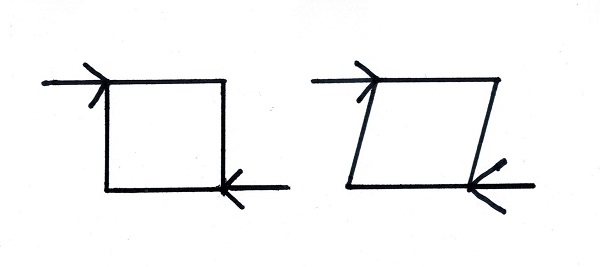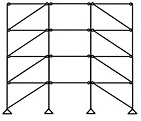Lateral loads
Lateral loads are live loads that are applied parallel to the ground; that is, they are horizontal forces acting on a structure. They are different to gravity loads for example which are vertical, downward forces.
The most common types are:
Wind load may not be a significant concern for small, massive, low-level buildings, but becomes more importance with height, the use of lighter materials and the use of shapes that may affect the flow of air, typically roof forms.
Significant seismic loads can be imposed on a structure during an earthquake. They are likely to be relatively instantaneous loads compared to wind loads. Buildings in areas of seismic activity need to be carefully designed to ensure they do not fail if an earthquake should occur.
Water pressure tends to exert a lateral load which increases linearly with depth and is proportional to the liquid density. Similarly, earth pressure (such as settlement) can be applied against below-ground structures such as basement walls, retaining walls, and so on.
Lateral loads such as wind load, water and earth pressure have the potential to become an uplift force (an upward pressure applied to a structure that has the potential to raise it relative to its surroundings). For more information, see Uplift force.
Structures should be designed carefully with likely lateral loads in mind. A structural element that is typically used to resist lateral loads is a shear wall. In simple terms, lateral forces could push over parallel structural panels of a building were it not for perpendicular shear walls keeping them upright. For more information see: Shear wall.
Similarly, bracing can be used to resist lateral loads. The beams and columns of a braced frame structure carry vertical loads, whilst the bracing carries the lateral loads. For more information, see Braced frame structure.
[edit] Related articles on Designing Buildings Wiki
- Bearing capacity.
- Bending moment.
- Biaxial bending.
- Braced frame.
- Dead loads.
- Floor loading.
- Force.
- Ground heave.
- Hurricane design considerations.
- Limit state design.
- Live loads.
- Loadbearing capacity.
- Moment.
- Point of contraflexure.
- Settlement of buildings.
- Shear force.
- Shear wall.
- Structural engineer.
- The design of temporary structures and wind adjacent to tall buildings.
- Torsion.
- Types of structural load.
- Uniformly Distributed Load.
- Uplift force.
- Vibrations.
- Wind load.
Featured articles and news
The UK's Modern Industrial Strategy: A 10 year plan
Previous consultation criticism, current key elements and general support with some persisting reservations.
Building Safety Regulator reforms
New roles, new staff and a new fast track service pave the way for a single construction regulator.
Architectural Technologist CPDs and Communications
CIAT CPD… and how you can do it!
Cooling centres and cool spaces
Managing extreme heat in cities by directing the public to places for heat stress relief and water sources.
Winter gardens: A brief history and warm variations
Extending the season with glass in different forms and terms.
Restoring Great Yarmouth's Winter Gardens
Transforming one of the least sustainable constructions imaginable.
Construction Skills Mission Board launch sector drive
Newly formed government and industry collaboration set strategy for recruiting an additional 100,000 construction workers a year.
New Architects Code comes into effect in September 2025
ARB Architects Code of Conduct and Practice available with ongoing consultation regarding guidance.
Welsh Skills Body (Medr) launches ambitious plan
The new skills body brings together funding and regulation of tertiary education and research for the devolved nation.
Paul Gandy FCIOB announced as next CIOB President
Former Tilbury Douglas CEO takes helm.
UK Infrastructure: A 10 Year Strategy. In brief with reactions
With the National Infrastructure and Service Transformation Authority (NISTA).
Ebenezer Howard: inventor of the garden city. Book review.
The Grenfell Tower fire, eight years on
A time to pause and reflect as Dubai tower block fire reported just before anniversary.
Airtightness Topic Guide BSRIA TG 27/2025
Explaining the basics of airtightness, what it is, why it's important, when it's required and how it's carried out.
Construction contract awards hit lowest point of 2025
Plummeting for second consecutive month, intensifying concerns for housing and infrastructure goals.
Understanding Mental Health in the Built Environment 2025
Examining the state of mental health in construction, shedding light on levels of stress, anxiety and depression.
The benefits of engaging with insulation manufacturers
When considering ground floor constructions.
Lighting Industry endorses Blueprint for Electrification
The Lighting Industry Association fully supports the ECA Blueprint as a timely, urgent call to action.

























